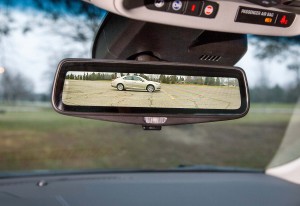
Cadillac will introduce a new streaming video alternative to the traditional rearview mirror late next year on the planned CT6 premium luxury sedan.
Cadillac will introduce a new streaming video alternative to the traditional rearview mirror late next year, a move the luxury maker says will result in significantly improved visibility on the planned CT6 premium luxury sedan.
The move lifts a page out of what was once science fiction technology. The new technology could signal the demise of conventional mirrors, in general, with automakers hoping to replace outside mirrors with video cameras, as well.
Cadillac clams the new streaming video mirror will improve a driver’s field of vision by as much as 300%, CT6 Chief Engineer Travis Hester suggesting, “The closest comparison to this kind of rear vision would be driving a convertible with the top down.”
A driver will see an image without the usual obstructions: the heads of backseat passengers, headrests and pillars. Caddy also boasts that the system will offer a crisper image in low-light situations, eliminating glare and reducing the impact of having someone driving behind with their brights on.
Part of the challenge, however, is to mount the camera where it delivers an image essentially equivalent to what the driver would normally see using a conventional rearview mirror. Also critical, keeping the camera lens clean and clear of obstructions, such as frost, mud or rain.
“One of the things we tried to do from the onset” was making the image in the mirror look completely natural, Hester told TheDetroitBureau.com. That effort – which began in 2011 — required working with a number of different potential hardware suppliers, while the software for the system was developed in-house.
Mounted on the car’s rear deck, the camera used in the CT6 will deliver a 1280 by 240-pixel image on an LDC display that will look, at first glance, like a conventional rearview mirror. The camera, meanwhile, will be treated with a hydrophobic coating that will shed water and dirt.
For those who want a conventional view of the world, a driver will simply be able to flip a toggle on the bottom of the LCD to get a traditional mirror.
The decision to offer the streaming video mirror on the new CT6 comes as little surprise. The big sedan will serve as Cadillac’s new flagship model and will offer a variety of other technological breakthroughs. That will include a system Caddy is calling SuperDrive, which will allow hands-free motoring on limited-access highways – a major step towards fully autonomous vehicles.
The CT6 is part of a wave of new products the General Motors luxury brand plans to add over the coming years in a bid to become more competitive with high-line leaders like Audi, BMW and Mercedes-Benz.
While the streaming video mirror will make its debut at the top of the Cadillac line-up, it is likely the technology – if well received by customers – would quickly migrate down the Caddy product spectrum.
Indeed, rival Nissan Motor Co. recently demonstrated a similar streaming mirror concept it says it may add to its vehicle portfolio in the next few years, most likely starting as an option.
(Nissan set to launch “smart” mirror. For more, Click Here.)
Video camera systems have become increasingly common in today’s cars. In fact, the National Highway Traffic Safety Administration plans to start requiring back-up cameras by 2016 – though they are now offered, at least in optional form, on more than half of all 2015 model-year products.
Honda recently launched a blind-spot detection system that uses a camera mounted onto the regular right sideview mirror. The image is displayed on the infotainment screen when the driver signals for a right turn.
(Click Here for details about how your smartphone may replace your car key.)
The next big step would come with the replacement of conventional outside mirrors. That has been an idea used on countless concept vehicles over recent decades. But new video technology has made it increasingly viable. Automakers are particularly fond of the idea because it would help reduce aerodynamic drag and wind noise.
(To see more about Toyota’s $126 million expansion in Michigan, Click Here.)
Battery-carmaker Tesla has indicated it wants to offer video sideview cameras on upcoming models, as have several other makers.
The problem is that such technology has not been approved by the National Highway Traffic Safety Administration. In fact, one of the reasons the Cadillac CT6 will have a two-mode system, including both a conventional mirror and the LCD display, is to meet federal regulations, noted Chief Engineer Hester. But NHTSA is studying several petitions calling for the approval of video camera mirror systems and could move within the next several years.
